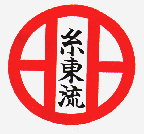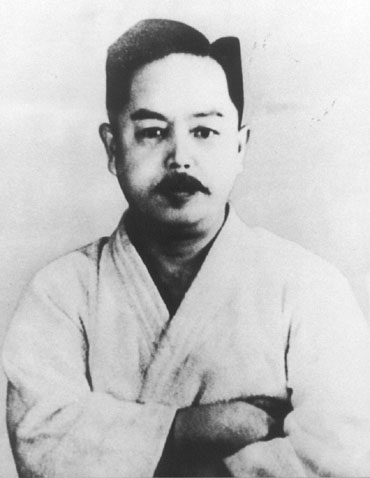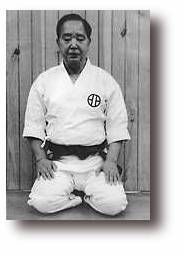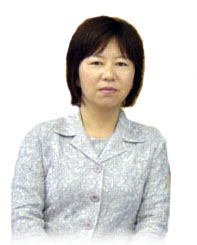
Seito Shito Ryu Karate Do
A Brief History of Shito Ryu Karate
Kenwa Mabuni
Karate is a method of fighting using blocks, punches, hand strikes and kicks to disable or defeat an attacker. Karate originated in the Ryukyu islands south of Kyushu (one of the four main islands of Japan). Okinawa is the largest of the Ryukyu islands and since early times has been a center for trading and commerce. Traders from mainland China, Korea, the Phillipines, Indonesia, Malaysia, Taiwan etc., often stopped at Okinawa to barter or sell goods and take on supplies. Thus, as with any trading center, the ideas of several cultures were exchanged. China, in particular, had a profound influence on the culture and social customs of Okinawa. Therefore, as the indigenious population developed a set of martial arts for self defense and police activities, they naturally had a strong Chinese flavor and incorporated may Chinese unarmed techniques. In fact, the original kanji or characters for Karate meant "Chinese Hand".
The true origins of Karate probably will never be fully determined because of a lack of written documentation. However, starting in the 1700's, some Karate experts do appear in various records. The exploits of individuals such as Sakugawa and later Matsumura were noted and the fighting prowess of such men has taken on almost legendary proportions. For a more thorough discussion of these early experts and the history of early Karate, the reader is refered to John Sells' excellent book Unante: The Secrets of Karate.
Shito Ryu Karate
was founded by Kenwa Mabuni (November 14, 1889 - May 23, 1952).
When he was 13 years old, Mabuni Sensei began training with Anko Itosu, a noted Karate master in the Shuri area of Okinawa. Itosu Sensei was not
only highly skilled in Budo but also a great innovator in teaching the
martial arts. Around 1905, Itosu Sensei introduced Karate into the Okinawan
public school system. Among other accomplishments, Itosu Sensei created
the Pinan (Heian) kata which are still practiced today as introductory
or intermediate forms in many schools. Itosu Sensei had an important effect
on Karate in the 20th Century. Evidence of this can be found in the number
of ryuha or Karate styles that trace their lineage back to him. This includes
notables such as Gichin Funakoshi, who was responsible for starting
Shotokan Karate, Chomo Hanashiro, Kentsu Yabe,
Choshin Chibana and others.
a noted Karate master in the Shuri area of Okinawa. Itosu Sensei was not
only highly skilled in Budo but also a great innovator in teaching the
martial arts. Around 1905, Itosu Sensei introduced Karate into the Okinawan
public school system. Among other accomplishments, Itosu Sensei created
the Pinan (Heian) kata which are still practiced today as introductory
or intermediate forms in many schools. Itosu Sensei had an important effect
on Karate in the 20th Century. Evidence of this can be found in the number
of ryuha or Karate styles that trace their lineage back to him. This includes
notables such as Gichin Funakoshi, who was responsible for starting
Shotokan Karate, Chomo Hanashiro, Kentsu Yabe,
Choshin Chibana and others.
About 1909, through an introduction by his friend Chojun Miyagi, Mabuni Sensei started to also train with Kanryo Higaonna (sometimes known as Higashionna). Higaonna Sensei was a expert form the Naha region of Okinawa. Through Higaonna Sensei, Mabuni Sensei learned kata such as Saiha, Sanchin, Seienchin, Seipai and others. Miyagi Sensei went on to found the Goju Ryu style of Karate.
In 1915, both Itosu Sensei and Higaonna Sensei passed away within a short time of one another. Mabuni Sensei continued his training. Ultimately, he and Miyagi Sensei joined with other students of Karate to start a research group aimed at practicing and spreading Karate. During this time Mabuni Sensei also trained in and taught various forms of Okinanwan weaponry or Ryukyu Kobudo.
In 1929, Mabuni Kenwa Sensei moved his entire family to Osaka. There he established a small dojo and began teaching his unique art Goju Ryu or Hard-Soft Style. In the 1930's, the Dai Nippon Butoku Kai (the Japanese martial arts sanctioning organization) began to demand the different groups applying for membership, be more specific in the description of their Karate systems, and pressured them to name their systems. Originally, Mabuni Kenwa Sensei thought to name his system Hanko Ryu or "half-hard" style. However, ultimately Mabuni Sensei decided on the name SHI TO which was formed by taking the first characters (kanji) from the names of his two primary teachers, Itosu and Higa(shi)onna. Thus, the name Shito Ryu has no literal meaning, but rather honors the two main teachers in Mabuni Kenwa Sensei's life. In the same context, the kata syllabus of Shito Ryu is still listed as having two lineages, Itosu Ke and Higaonna Ke.
Mabuni Kenwa Sensei worked tirelessly to teach Karate throughout Japan. His efforts brought him into contact with other people who were essential to the growth of Karate in Japan. The impact that Mabuni Kenwa had on the development of Japanese Karate was tremendous. Many groups trace an element of their lineage back to him. Mabuni Kenwa died on May 23rd, 1952.
Kenzo Mabuni

This biography is abstracted from the International Seito Shito-Ryu Karate-Do website:
KENZO MABUNI was born on May 30, 1927 at Akahira-Machi, Shuri City, in Okinawa. His family moved to Osaka City in 1929, when he was 2 years old, and he remained in his father's house until now. He obtained permission from his father to join his school when he was 13 years old and therefore studied SHITO-RYU KARATE-DO for 65 years. He first obtained his SHODAN (first degree blackbelt) on August 1, 1943 . When he passed away in 2005, as the second Headmaster, he held the rank or JUDAN (10th degree).
His organization, NIPPON KARATE DO KAI (formerly known as DAI NIPPON KARATE DO KAI), was founded by his father in 1939. After his father's death in 1952, his mother, Mrs. KAME MABUNI, came to Kenzo Mabuni and requested that he take over the style. Kenzo Mabuni could not decide at that time and went into seclusion for two years to contemplate this great responsibility. In the end, he decided to accept this responsibility and became the inheritor of his father's lineage, making him the 2nd SOKE of SHITO-RYU and successor to this organization. His father left him the SHITO-RYU name, his complete syllabus, and the DOJO with the Association name NIPPON KARATE DO KAI. All these remain intact to this day. He followed his father's syllabus exactly the way it was written down in 1929 and that's why he called it SEITO SHITO-RYU, or PURE, TRUE SHITO-RYU.
From that time, Kenzo Mabuni dedicated his life to preserving the true lineage of his father's karate. He was not concerned with politics or image and remained unknown to the outside world while his older brother and others were spreading their influence in the name of Shito Ryu Karate. In 1993, upon the request of his good friend Osamu Ozawa (Shotokan master), Kenzo Mabuni travelled to Las Vegas and exposed the world to Seito (pure) Shito Ryu, the true karate of his father, Kenwa Mabuni. In April of 1994, Kenzo Mabuni conducted seminars in Albany, New York and Phoenix, Arizona. Subsequent to these seminars, Kenzo Mabuni established the Shito Ryu Karate Do Kai of America (now called Shito-Ryu USA Karate Do Kai), comprised of Dojos that had requested of him consideration as his direct students and received formal acceptance by his senior instructors, the Nippon Karate Do Kai Shihan Kai.
Kenzo Mabuni's organization, Shito-Ryu International Karate Do Kai, now has branches in North and South America, Europe, Asia, and the Oceania regions. He serves as the President (KAICHO) and Governor / Grandmaster (SOKE).
Kenzo Mabuni emphasized the training of Karate based on his father's principle that: "Kata (form) is KARATE". KATA is the essence of Karate and in training, one should follow his policy: 75% Kata training and 25% Kumite (free or organized sparring) training, besides doing the regular KIHON (Basics) and exercises. He trained under the watchful eye of his father and would practice hundreds of times for a period of 3 months or more just to understand and perfect ONE single KATA.
He advised that one should take note of the following points when practicing KATA:
- KATA should start and end with REI (bow)
- Correct Basic Techniques
- Breathing
- Dachi (Stances)
- Posture
- HAPPO TENSHIN (8 Directions)
- CHAKUGAN (Focusing)
- BUNKAI (Meaning and Application)
- ZANSHIN (Awareness)
- Repetition - to perfect the KATA
Mabuni Kenzo's vision was that he would continue his father's work in promoting this traditional martial art and teach only the correct and original form of SHITO-RYU KARATE-DO. He passed away at 2:45 pm on June 26, 2005 in Osaka, Japan.
Personal Observations (DGM):
Because of his teachings and devotion to his students, Mabuni, Kenzo Soke Sensei was considered by many of us to be our father in Karate. Certainly he fundamentally changed my understanding and practice of Karate-Do. Wjhen he first visited my dojo in 1994, I was struck by his quiet and patient demeanor. When he returned the next year and stayed with us for an entire month, I was fortunate to get to know him even more.
Kenzo Sensei would show a technique or kata and then begin practice. He would make sure that you got the fundamental movement then tell you to practice on your own while he watched. Kenzo Sensei almost never told any one that they "had to do" something a certain way (unless you were completely confused). Rather, he waited for you to ask if you were correct (based on your practice) and then follow up with more questions. One of the most important questions was: "What do you do Sensei? " Very often his answer would take the form of: "I do it this way, but you have to do it the way that is best for you.". He emphasized was that body structure and movement is different between different individuals. Therefore, you must practice and test a movement to make it optimal for yourself. We had all heard or read this approach before. However, Mabuni, Kenzo Sensei was the first budo teacher I experienced who truly put this into practice.
Mabuni, Kenzo came to visit us each year in America, often staying in our homes and playing with our children. Then we would visit him and his students in Japan. It really was the formation of an extended family. Over the years of living and training with him, many of us had some amazing and wonderful experiences. One night after dinner in my home, Kenzo Sensei told us about sitting on his "Uncle" Chojun (Miyagi)'s knee and listening to his father and Miyagi Sensei decide to name the new kata they had created. The chose trhe name "Tenshou" because of the use of the hans and wrist. Truly it is best to learn history from people who had lived it.
All of Mabuni, Kenzo Soke Sensei's students in America have stories like these. I think you can understand why we stil miss him everyday.
10 instagram followers prada employee discount prada authentic prada dupe amazon prada derby shoes restaurant near rosemont instagram followers report large framed cork boards prada shoes price prada men's backpacks prada bookbag chatgpt 应用 mens prada vest scottish corners wholesale building materials prada espadrilles sale nude prada bag tomagatchis prada hexagon sunglasses underwood construction aeropostale ofertas instagram followers private instagram statistics followers fake sideburns realistic prada moccasins prada odette bag chatgpt jailbreak github prada cleo silver winthrop red apple prada t shirts prada boston bag prada shoe price who bought chatgpt online shop gucci captain gear prada sequin dress spam instagram followers arche shoes outlet cardinal building supply st.louis prada bag repairs kiran patel high school captain hats for sale prada factory outlet benefits of chatgpt botta uno 24 neo prada lingerie shop gucci online pink prada slides chatgpt competitor meijs motorman for sale chatgpt salesforce prada pr 07ys 600 followers instagram saks prada shoes chatgpt programming prada heel boots جوتشي prada multipochette chloe bags outlet athenian academy pinellas chatgpt copyright instagram followers private prada mens boots prada denim bra yachting cap prada ski boots גוצי prada original bag chatgpt api pricing fantastic mr fox whack bat outlet fashion online ugg online sale stores mix marketing athenian academy charter school clearwater prada 18wv eyeglasses followers instagram free prada wikipédia gucci deutschland prada shop linnea quigley night of the living dead prada sport shoes prada hoodie womens prada wicker clutch awesome-chatgpt prada second hand 1500 instagram followers gucci sklep online prada 18wv prada purses pink chatgpt hacked mutual followers instagram leona lewisrun lyrics prada ferry bag gucxi discord chatgpt t shirt prada fantastic mr fox whack bat private dinner restaurant usa outlet online tamagatchis prada 15ws sunglasses chatgpt download windows dr james smith tampa fl cahier prada bag dan command chatgpt captain epaulettes camisa prada hombre hair punch prada milano mens wearing prada prada sneakers cheap prada gifts chatgpt and microsoft raffia prada bag rushmax instagram followers ugg online sale stores
Miwako Mabuni
The third Soke or headmaster of Shito Ryu is Miwako Mabuni. She is the elder of Mabuni Kenzo's two daughters. She assumed the position of Tsukasa Soke after her father's death and with the full approval and support of the shihan kai (Head Council of Teachers) Over the years since Mabuni, Kenzo Sensei's passing, Tsukasa Soke has done an excellent job of keeping our Karate family together and helping Shito Ryu grow. This is a difficult and demanding task (to be a soke) and we deeply appreciate her efforts. She can be contacted via the International website links.

Home / Class Schedule / Curriculum / Curriculum as Kata / Kata Syllabus / Godoshin / Links / Contact